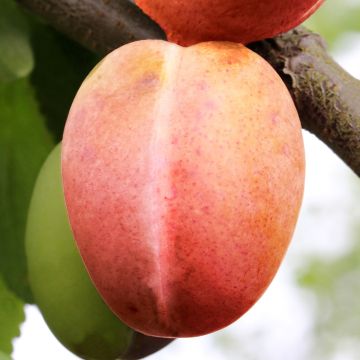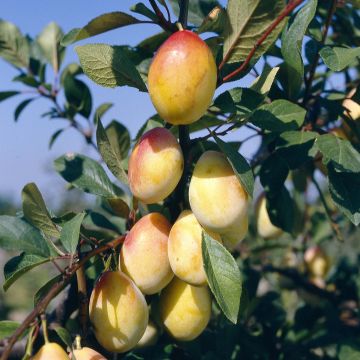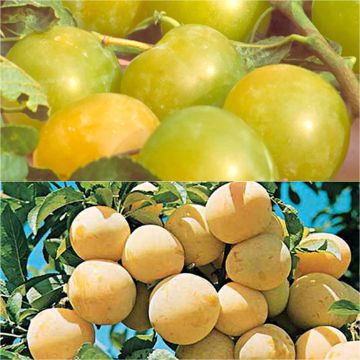

Prunus domestica Stanley - Common plum
Prunus domestica Stanley - Common plum
Prunus domestica Stanley
European plum, Common plum, Garden plum
Un bel arbre bien formé; bien emballé, expédié et reçu rapidement.
Henri C., 20/12/2019
Special offer!
Receive a €20 voucher for any order over €90 (excluding delivery costs, credit notes, and plastic-free options)!
1- Add your favorite plants to your cart.
2- Once you have reached €90, confirm your order (you can even choose the delivery date!).
3- As soon as your order is shipped, you will receive an email containing your voucher code, valid for 3 months (90 days).
Your voucher is unique and can only be used once, for any order with a minimum value of €20, excluding delivery costs.
Can be combined with other current offers, non-divisible and non-refundable.
Why not try an alternative variety in stock?
View all →This plant carries a 6 months recovery warranty
More information
We guarantee the quality of our plants for a full growing cycle, and will replace at our expense any plant that fails to recover under normal climatic and planting conditions.

Description
The Stanley Plum is a vigorous variety, with quick fruiting and good regular production. It produces large, elongated, dark purple-red fruits that turn almost black when ripe. Their flesh is green, firm, and sweet. They are ideal for making prunes. Harvest takes place in early September. The Stanley Plum is self-fertile and an excellent pollinator.
The word "Quetsche" means "Damson Plum" in Alsatian. Quetsche plums therefore originate from Syria, a country that has supplied many varieties of plums since the Middle Ages. The Stanley Quetsche variety was selected in the United States, at the Geneva Station in New York, in 1926. It is the result of cross-breeding between the Prune d'Ente and the Grand Duke.
This fruit tree naturally grows up to 8 meters (26 feet) tall when fully mature. Its upright habit gives it an elegant silhouette in the garden. It is not very demanding in terms of soil type, as long as there is no limestone present. Its leaves are ovate, almost oblong, with serrated edges and a slightly pubescent surface. Flowering occurs in late March and is quite spread out. The tree becomes completely covered with white flowers that appear on the previous year's branches. They are self-fertile. The tree itself is an excellent pollinator for other plum trees. The large, elongated fruits are dark purple-red, turning almost black when ripe. Their flesh is green, firm, and sweet, making them ideal for making prunes.
Plums can be eaten raw at the base of the tree, in fruit salads, as well as in desserts, pastries, and as accompaniments to meat and dishes. They can be transformed into jams, of course, but also into fruit in syrup, compotes. They can also be used to make brandy. You can also dry them in the sun during the summer, pitted and hung in a garland on a string, or in the oven.
Report an error about the product description
Prunus domestica Stanley - Common plum in pictures




Plant habit
Fruit
Flowering
Foliage
Botanical data
Prunus
domestica
Stanley
Rosaceae
European plum, Common plum, Garden plum
Cultivar or hybrid
Other Plum Trees
View all →Planting and care
Easy to grow, the Stanley Plum grows in any type of light, rich, neutral or acidic soil, moist but not excessively wet and without limestone. Ensure proper drainage in the planting hole with a layer of gravel. Dig a hole two to three weeks before planting, twice as wide and deep as the pot. On the day of planting, place the tree with its pot in a basin of water, allowing the root ball to be moistened by capillary action. Add compost to the bottom of the hole. Place the tree in the hole and fill with a mixture of soil and compost. Do not bury the graft union. Firmly pack the soil around the base. The root ball should be completely covered. Water thoroughly.
You can add a small handful of wood ash, rich in potash, during the winter to improve fruiting.
Planting period
Intended location
Care
-
, onOrder confirmed
Reply from on Promesse de fleurs
Haven't found what you were looking for?
Hardiness is the lowest winter temperature a plant can endure without suffering serious damage or even dying. However, hardiness is affected by location (a sheltered area, such as a patio), protection (winter cover) and soil type (hardiness is improved by well-drained soil).

Photo Sharing Terms & Conditions
In order to encourage gardeners to interact and share their experiences, Promesse de fleurs offers various media enabling content to be uploaded onto its Site - in particular via the ‘Photo sharing’ module.
The User agrees to refrain from:
- Posting any content that is illegal, prejudicial, insulting, racist, inciteful to hatred, revisionist, contrary to public decency, that infringes on privacy or on the privacy rights of third parties, in particular the publicity rights of persons and goods, intellectual property rights, or the right to privacy.
- Submitting content on behalf of a third party;
- Impersonate the identity of a third party and/or publish any personal information about a third party;
In general, the User undertakes to refrain from any unethical behaviour.
All Content (in particular text, comments, files, images, photos, videos, creative works, etc.), which may be subject to property or intellectual property rights, image or other private rights, shall remain the property of the User, subject to the limited rights granted by the terms of the licence granted by Promesse de fleurs as stated below. Users are at liberty to publish or not to publish such Content on the Site, notably via the ‘Photo Sharing’ facility, and accept that this Content shall be made public and freely accessible, notably on the Internet.
Users further acknowledge, undertake to have ,and guarantee that they hold all necessary rights and permissions to publish such material on the Site, in particular with regard to the legislation in force pertaining to any privacy, property, intellectual property, image, or contractual rights, or rights of any other nature. By publishing such Content on the Site, Users acknowledge accepting full liability as publishers of the Content within the meaning of the law, and grant Promesse de fleurs, free of charge, an inclusive, worldwide licence for the said Content for the entire duration of its publication, including all reproduction, representation, up/downloading, displaying, performing, transmission, and storage rights.
Users also grant permission for their name to be linked to the Content and accept that this link may not always be made available.
By engaging in posting material, Users consent to their Content becoming automatically accessible on the Internet, in particular on other sites and/or blogs and/or web pages of the Promesse de fleurs site, including in particular social pages and the Promesse de fleurs catalogue.
Users may secure the removal of entrusted content free of charge by issuing a simple request via our contact form.
The flowering period indicated on our website applies to countries and regions located in USDA zone 8 (France, the United Kingdom, Ireland, the Netherlands, etc.)
It will vary according to where you live:
- In zones 9 to 10 (Italy, Spain, Greece, etc.), flowering will occur about 2 to 4 weeks earlier.
- In zones 6 to 7 (Germany, Poland, Slovenia, and lower mountainous regions), flowering will be delayed by 2 to 3 weeks.
- In zone 5 (Central Europe, Scandinavia), blooming will be delayed by 3 to 5 weeks.
In temperate climates, pruning of spring-flowering shrubs (forsythia, spireas, etc.) should be done just after flowering.
Pruning of summer-flowering shrubs (Indian Lilac, Perovskia, etc.) can be done in winter or spring.
In cold regions as well as with frost-sensitive plants, avoid pruning too early when severe frosts may still occur.
The planting period indicated on our website applies to countries and regions located in USDA zone 8 (France, United Kingdom, Ireland, Netherlands).
It will vary according to where you live:
- In Mediterranean zones (Marseille, Madrid, Milan, etc.), autumn and winter are the best planting periods.
- In continental zones (Strasbourg, Munich, Vienna, etc.), delay planting by 2 to 3 weeks in spring and bring it forward by 2 to 4 weeks in autumn.
- In mountainous regions (the Alps, Pyrenees, Carpathians, etc.), it is best to plant in late spring (May-June) or late summer (August-September).
The harvesting period indicated on our website applies to countries and regions in USDA zone 8 (France, England, Ireland, the Netherlands).
In colder areas (Scandinavia, Poland, Austria...) fruit and vegetable harvests are likely to be delayed by 3-4 weeks.
In warmer areas (Italy, Spain, Greece, etc.), harvesting will probably take place earlier, depending on weather conditions.
The sowing periods indicated on our website apply to countries and regions within USDA Zone 8 (France, UK, Ireland, Netherlands).
In colder areas (Scandinavia, Poland, Austria...), delay any outdoor sowing by 3-4 weeks, or sow under glass.
In warmer climes (Italy, Spain, Greece, etc.), bring outdoor sowing forward by a few weeks.














































